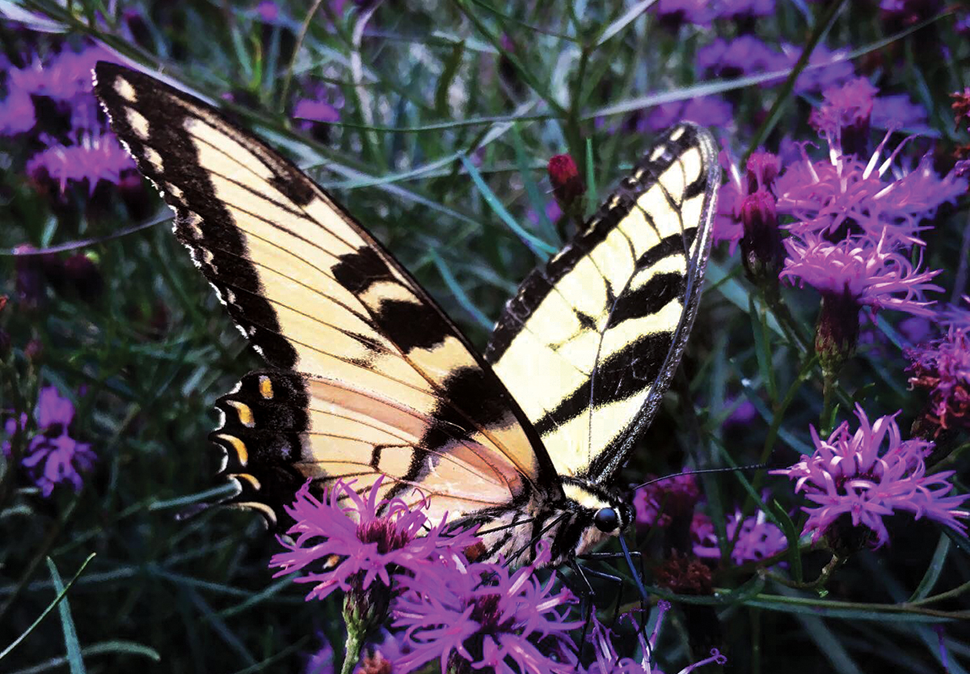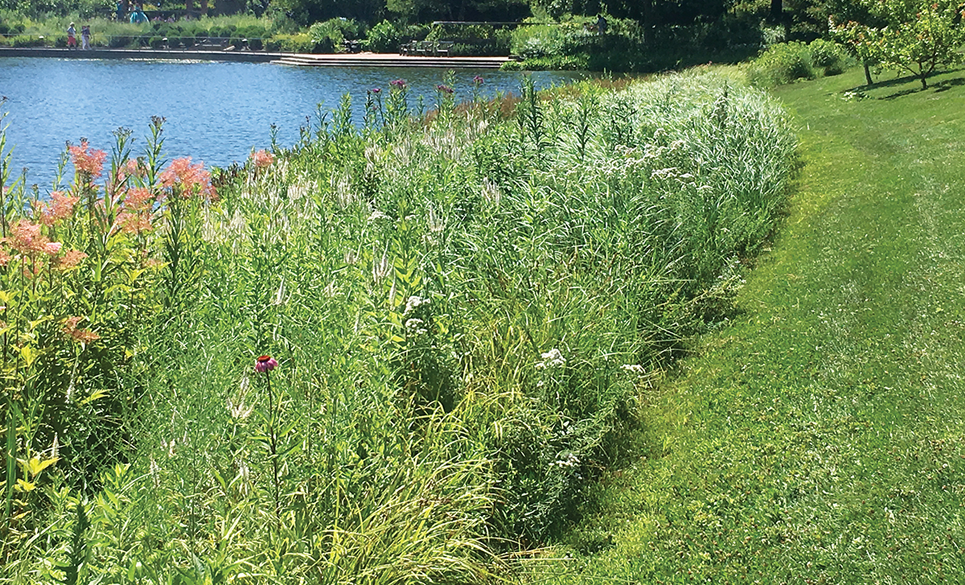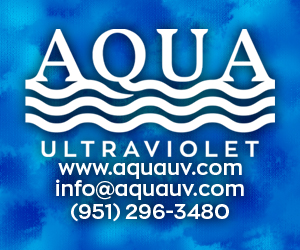
by John Mark Courtney & Victoria Holderer, Kind Earth Growers
Nothing quite compares to the tranquility of sitting next to a pond with a hot cup of coffee at sunrise. Listening, you can hear some groggy frogs croaking their last calls of a long night and a cheery good-morning whistle from a male cardinal perched in a shrub along the pond shore, getting ready to begin his seed foraging for the day. As the sun rises higher in the sky, a growing chorus of birdsongs fill the air, chatty and chirpy, getting excited for their morning meal. A group of barn swallows begin their swooping acrobatics, skimming the water surface and picking off the tiniest of insects as they soar around like small fighter jets.

A pond habitat with diverse, flowering native plants, berry-bearing trees and shrubs and a meandering shoreline with shallow pockets can attract a vast array of insects, amphibians and birds. They all come to forage, bathe or take cover by the water. Whether a garden or waterscape is old or new, adding a water feature to it is sure to attract wildlife. Accentuating a wet area of a property by excavating a vernal pool or small pond can provide a perfect habitat for salamanders, frogs and moisture-loving perennials. These pools create a home for many micro and macro-invertebrates like dragonflies and tadpoles. Pollinators and butterflies come by the hundreds to find nectar and are followed by birds hunting for a seed and caterpillars to feast on.
The key to attracting all this wildlife lies with the quantity and quality of host plants available in these locations. By choosing to plant with a diverse palette of native plants, you are using species that have adapted through the millennia to attract a wide array of pollinators, songbirds and wildlife to this site.
Host Plants

Host plants are plants that an organism lives on and off. The best example of this is milkweed (Asclepias) and the monarch butterfly. The milkweed is the only plant the monarch butterfly will lay its eggs on for its emerging caterpillars to feed on. It also provides much-needed nectar for the adult monarch, hummingbird clearwing moth and the red admiral butterfly. In planting these native host plants in and around your pond and water feature, you are creating a habitat for moth and butterfly caterpillars, which in turn is providing food to attract songbirds.
Host plant flowers come in many shapes, and each shape attracts different organisms. Tubular flowers like cardinal flower (Lobelia cardinalis) and bee balm (Monarda didyma) attract hummingbirds. Wide, flat-pad-shaped flowers like milkweed, goldenrod (Solidago) and Joe Pye weed (Eutrochium fistulosum) provide great landing pads for butterflies and bumblebees to sip nectar and gather pollen. Including a wide variety of shapes and sizes will ensure greater diversity.
Plant Diversity
To begin creating a biodiverse habitat for winged visitors, start by adding a diverse plant palette of native species and host plants. A higher diversity of plant species equals a higher variety of animal life due to the variety of nectar and food. Introducing locally native species to a pond or wetland garden will attract many types of pollinators and birds to your garden. This is because these native plants provide an essential food source.
From where I am writing in southeastern Pennsylvania, moisture-loving native plants like cardinal flower, rose milkweed (Asclepias incarnata) and narrow-leaf mountain mint (Pycanthemum tenuifolium) are all fantastic options that can provide abundant food for pollinators and birds. Cardinal flower, with its bright-red tubular flowers, is a favorite of the ruby-throated hummingbird. Aquatic species like arrow arum (Peltandra virginica) provide abundant seeds in the late summer that ducks can’t resist. Broadleaf arrowhead (Sagittaria latifolia), with its starchy tubers, or “duck potatoes,” are known favorites for ducks in the long winter months and early spring.

Shrubs and small fruiting trees are also essential in supporting and attracting wildlife. Moisture-loving shrubs like red chokeberry (Aronia arbutifolia) produce clusters of red berries that are a critical late-winter food source for birds. Button bush (Cephalanthus occidentalis), with its white fragrant flowers, is a favored nectar source for butterflies and native bees. Its hard seeds are persistent through early winter, providing high-quality fat to birds in the cold months. Adding canopy and shelter to the pond shore will also help attract certain bird species like yellow warblers, cedar waxwings and bluebirds.
The Naturalistic Drift
When designing and constructing a pond or wetland garden, it is important to keep the design as naturally inspired as possible. Natural ponds are gently sloping, sometimes open-shore habitats. Instead of lining the entirety of a pond with boulders, keep sections of it open so that different types of wildlife are able to access this resource. Some birds like the mallard duck and the northern pintail prefer shallow water with an adjacently exposed mudflat area for entering and exiting easily.
Many species have preferences for different depths of water. Bees and butterflies require shallow pools with gently sloped edges so they can get a drink of water. Great blue herons require at least 8 inches of water to wade and hunt. On average, a variety of depths ranging from 1 to 8 inches up to 2 to 5 feet provide an optimum variety of habitat suitable for all species.

A garden that welcomes, feeds and provides cover to winged friends is a garden with movement and song. Incorporating more diversity in and around ponds and water features is the best way to ensure that pollinators and birds will be attracted to the garden year after year. This buzz of activity will draw out even the most disinterested client, creating a new interest and passion.
Getting people outside is the goal. Once they’re outside, the possibilities are endless.


